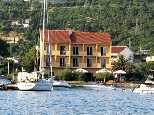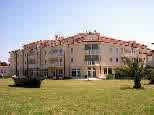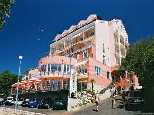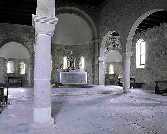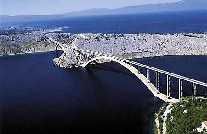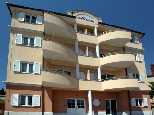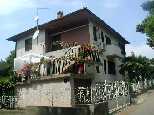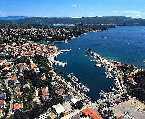


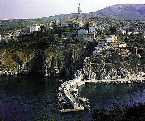


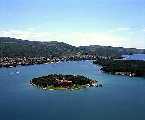 |
The Island of Krk
Krk Island is located in the Bay of Kvarner. With a surface
area of 409 km2, it is the largest of the Adriatic islands (38 km in length
and 20 km wide). The island has a population of approximately 16,500 inhabitants.
Its highest peak is Obvoz (569 m), and is located in the southern karst
area of the island. The harsh northwestern island coastline is plain, bare
and sheer, which during "bura" (cold and strong northerly wind) periods
can also be dangerous. The southwestern and southeastern island coastline
is elaborated with many coves, bays and pebble beaches. The average atmospheric
temperature in January is 5.6°C while in July it is 24.1°C. Annual
precipitation is about 1,000 mm. Two lakes can be found on the island –
"Jezero" (in the North near Omisalj) and "Ponikve" (in the central part
of the Island). The lakes supply surrounding settlements with water. 30.9%
of the Island's surface area, particularly in its central and western areas,
is forested or cultivated in Mediterranean fruit and vegetable cultures,
vineyards or olive groves. The northern and southern areas of the Island
are characterized by rough stone strewn ground and pastureland. With the
exception of Dobrinja, all larger settlements (Krk, Baska, Malinska, Njivice,
Punat) are situated along the coast. Krk Island is connected by bridge
to the mainland and by ferry links to neighboring islands Cres (Valbiska-Merag)
and Rab (Baska-Lopar). "Rijeka" airport near Omisalj maintains air routes
within Croatia and during the holiday (Summer) season with international
destinations.
The Town of Krk is the largest settlement within
Krk Bay, located in the southwestern part of the island, and has a population
of around 3.000 inhabitants. Of the older settlements on the Island (Omisalj,
Dobrinj, Vrbnik and Baska), Krk is the only one that is situated immediately
beside the sea. Its narrow streets and "warn" stone paving make the Old
Town Center of Krk very appealing. Interesting visits include Frankopan
Castle (XVth century) in the center of town, Krk Cathedral (XIIIth century),
as well as several eminent galleries.
Malinska is a tourist center in the northwestern
part of the Island and accommodates about 1,000 inhabitants. At the beginning
of the IXth century, Malinska underwent a transformation from a small village
into a harbor settlement. Because of good ties with the mainland and mild
climate, at the turn of the XXth century Malinska developed into a tourist
destination, experiencing a boom between the two world wars and especially
after the Second World War. Numerous beaches, natural beauty of a vibrant
setting, cultural focal points and a mild Mediterranean climate with over
2,200 hours of sunshine per year, are features that attract most visitors,
while the enchantment of the sea, sun and summer leave nobody indifferent.
A high class hotel complex has been constructed in Haludovo Bay.
Punat is located in the southern part of the Island
in one of the most sheltered and most beautiful of bays. It is well known
by recreational sailors for its Marina "Punat", one of the leading nautical
centers on the Croatian coast. Punat has approximately 1,700 inhabitants.
The name "Punat" originates from the Latin word "Pons", meaning bridge,
which in past times linked the narrow pass in Puntarska gully from the
south. In the middle of Puntarska Gully is tiny Kosljun Island with its
Franciscan friary and small harbor.
Vrbnik is located in the central area of the northeastern
coastal section of Krk Island, overlooking Velebit Channel, beside the
Gully of Sv. Marko (St. Mark). Vrbnik is located directly above the sea,
on a 49 m high cliff, whose northern face falls almost vertically into
the sea. Vrbnik has about 1,000 inhabitants. Access from the sea is difficult
while a steep road leads from the harbor into town. In the nearby bay of
Zgribnica, with its crystal clear sea water, a beach has been adapted for
bathing. The harbor is well protected from winds. Vrbnik is particularly
known for its refined wines (Zlatna Vrbnicka Zlahtina), making visits to
wine cellars for wine connoisseurs quite worthwhile.
Baska is located in the southwestern part of Krk
Island. Because Baska is positioned at the termination point of the island
road, it is also often known as "Kraje" (the edge). Baska is inhabited
with about 820 persons, who in terms of dialect and lifestyle differ from
all the other inhabitants of the island. Beside the old, densely developed
town center, a new part of town has emerged, containing numerous hotels
and guesthouses (pensions). The location of Baska has enabled continuous
development and prosperity, by which today it is a recognized tourist destination,
placing Baska in the "top ten" tourist destinations on the Adriatic Sea. |


